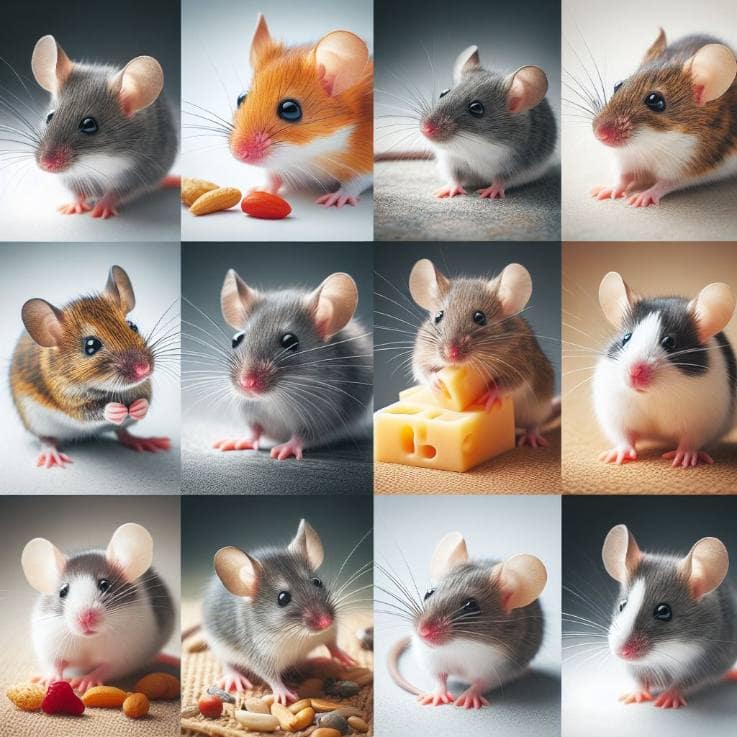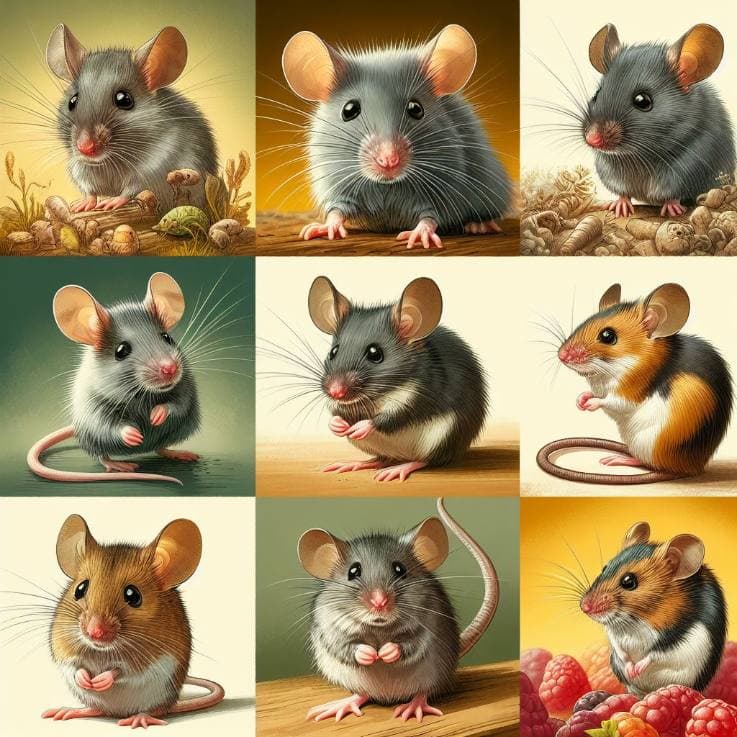
Discover the hidden world of common household mice and unravel the secrets of these elusive creatures in “The Ultimate Guide to Identifying Common Household Mice: Know Your Rodents!” Prepare to be captivated as we delve into the fascinating realm of tiny paws, twitching whiskers, and mischievous adventures.
Whether you’re a curious homeowner seeking to identify and understand these intruders or simply an enthusiast hoping to expand your knowledge, this comprehensive guide promises to be your ultimate companion.
So, grab your magnifying glass and embark on a thrilling journey to unravel the mysteries of these adorable yet often misunderstood creatures. Get ready to say goodbye to mouse-related uncertainties and hello to a newfound understanding of our tiny companions!
Key Takeaways
- Mice are common household rodents that reproduce quickly and seek shelter and food in human dwellings.
- They can carry diseases, cause property damage, and contaminate food.
- Identifying signs of a mouse infestation, such as droppings, gnaw marks, and nests, is important.
- Preventing infestations involves sealing entry points, proper food storage, and regular cleaning.
- Traps and baits can be used for control, or professional pest control services can be hired.
- Take proactive measures to protect your home and family from mice.
Physical characteristics of mice
Mice are small rodents typically measuring 2.5 to 4 inches long, excluding their tails. They have round bodies with short legs and large ears. Mice come in various colors, including gray, brown, and black. Their fur is usually smooth and soft.
One of the most distinctive features of mice is their long tails, which can measure up to 4 inches in length. The tail is usually hairless and scaly. Mice use their tails for balance and communication, as they can twitch and move them in various ways to convey different messages.
Differences between house mice and other rodent species

While mice may be the most common rodent species in households, they are not the only ones. Rats, voles, and other rodents can invade homes and cause similar problems. It is important to distinguish between different species to control infestations effectively.
House mice are smaller than rats, with a more slender body shape. Rats, on the other hand, are larger and have a more robust build. Voles are similar in size to mice but have stockier bodies and shorter tails. Additionally, voles are herbivores and primarily feed on plants, while mice are omnivores and will eat a variety of foods.
Identifying common household rodent types in your home, you can look at their droppings. Mouse droppings are small and pellet-shaped, while rat droppings are larger and more cylindrical. Vole droppings are similar in size to mouse droppings but are more rounded.
1. House Mouse (Mus musculus)
The house mouse, scientifically known as Mus musculus, is the most widespread species of mouse found in homes. They are small in size, typically measuring around 2.5 to 3.5 inches in length, excluding the tail. House mice have a pointed snout, large ears, and a long tail that is usually equal to the length of their body.
These mice can vary in color, ranging from light brown to gray, with a lighter shade on their underbelly. House mice are excellent climbers and can easily scale walls and other vertical surfaces. They are primarily nocturnal, meaning they are most active during the night.
2. Deer Mouse (Peromyscus maniculatus)
The deer mouse, also known as Peromyscus maniculatus, is another common mouse species found in households. They are slightly larger than house mice, measuring approximately 3.5 to 4 inches in length, excluding the tail. Deer mice have a more slender and agile body compared to the house mouse.
These rodents have a distinctive bi-colored appearance with a reddish-brown back and white underparts. They also have large eyes and ears. Deer mice are typically found in rural areas but can occasionally make their way into homes located near fields or wooded areas.
3. Field Mouse (Apodemus sylvaticus)
The field mouse, scientifically known as Apodemus sylvaticus, is commonly found in gardens and fields but can also venture into homes seeking food and shelter. They are similar in size to house mice, measuring around 2.5 to 3.5 inches in length, excluding the tail.
Field mice have a brownish-gray fur with a lighter underbelly. They have a blunt snout and relatively large eyes and ears compared to their body size. These mice can be excellent climbers and are known for their ability to build intricate nests.
4. White-Footed Mouse (Peromyscus leucopus)
The white-footed mouse, scientifically known as Peromyscus leucopus, is commonly found in wooded areas across North America. However, they can also enter homes located near forests or green spaces. White-footed mice are similar in size to deer mice, measuring around 3.5 to 4 inches in length, excluding the tail.
These mice have a reddish-brown back with a distinct white underbelly and feet, which gives them their name. They have large eyes and ears and a slender body. White-footed mice are primarily nocturnal but may occasionally be active during the day.
5. Harvest Mouse (Micromys minutus)
The harvest mouse, scientifically known as Micromys minutus, is one of the smallest rodents found in Europe and Asia. They are typically not household pests but may occasionally find their way into homes located near fields or farmland.
Harvest mice are incredibly tiny, measuring around 2 to 2.5 inches in length, excluding the tail. They have a reddish-brown fur with a white underbelly and a long tail that is usually longer than their body. These mice are excellent climbers and can construct intricate nests among tall grasses and reeds.
Mouse Identification Guide: Unmasking Your Tiny Tenants
This 5-minute video by Critter Control, a pest control expert, is like a detective kit for your eyes! Get ready to:
- Meet the suspects: Learn about the most common house and field mice and their key physical features like fur color, tail length, and size.
- Spot the clues: Discover telltale signs of their presence, from droppings and gnaw marks to nesting materials and tracks.
- Crack the case: Examine your newfound knowledge with interactive quizzes and close-up shots to solidify your identification skills.
No more mystery! With this informative and engaging video, you’ll be a mouse identification pro in no time. So grab your magnifying glass and popcorn, and prepare to become the Sherlock Holmes of your own home!
Remember, knowing your enemy is half the battle! Once you identify the type of mouse you’re dealing with, you can choose the most effective strategies for control and prevention. Now, go forth and conquer those tiny trespassers!
Conclusion and final thoughts on identifying common household mice
In conclusion, don’t underestimate a small mouse’s impact on your home and family. These tiny rodents may seem harmless, but they can quickly multiply and wreak havoc if left unchecked. From carrying diseases to causing property damage, mice can create many problems.
By being vigilant and identifying the signs of a mouse infestation, you can take the necessary steps to protect your home. Seal up entry points, store food properly, and maintain cleanliness to deter these unwanted guests. If all else fails, don’t hesitate to call the professionals with the expertise to handle the situation.
Remember, the key to a mouse-free home lies in your hands. Take action today to safeguard your loved ones and create a peaceful, rodent-free environment. Don’t let these tiny creatures turn your home into their playground. Stay one step ahead and keep your home mouse-free.
References
- Critter Control’s YouTube video: https://www.youtube.com/watch?v=SNsIf-1Lm9o This 5-minute video is a detective kit for your eyes! Learn key features of house and field mice, spot their clues, and test your skills with quizzes.
Opens in a new windowwww.reconnectwithnature.org
house mouse and a field mouse sidebyside for comparison
- National Pest Control Association’s infographic: https://www.familyhandyman.com/list/how-to-identify-rodents-in-your-home-and-yard/ This handy infographic visually compares house mice, deer mice, and voles based on size, tail, fur color, and droppings.
Opens in a new windowwww.holderspestsolutions.com
infographic comparing house mice, deer mice, and voles
- Woodland Trust’s blog: https://www.woodlandtrust.org.uk/blog/2022/03/types-of-uk-mice/ This blog post offers detailed descriptions and pictures of house mice, field mice, and shrews, highlighting their distinctive features.
Opens in a new windowwww.woodlandtrust.org.uk
house mouse, field mouse, and shrew sidebyside for comparison
2. Interactive Resources:
- University of Illinois Extension’s Rodent Identification Quiz: https://extension.illinois.edu/insects Test your knowledge with this interactive quiz featuring images and descriptions of various rodent species found in Illinois.
- PestWorld’s Rodent Identification Tool: https://www.pestworld.org/news-hub/pest-articles/rodents-101/ This online tool guides you through a series of questions about size, tail, and habitat to help you narrow down the possible rodent suspects.

Welcome to micegoneguide.com, your go-to resource for eliminating rats and mice. Say goodbye to rodent infestations with our expert tips and strategies. Visit us now and reclaim your space!

